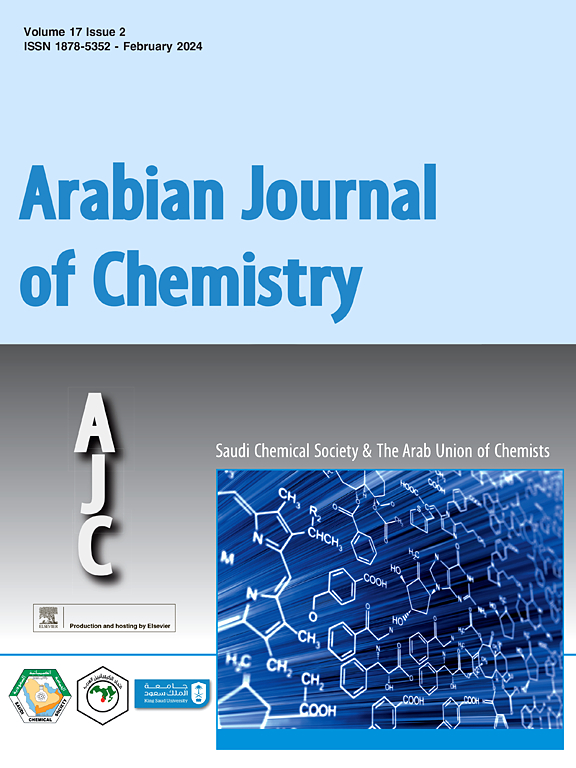Green chemistry-based synthesis of gold nanoparticles using Nicotiana plumbaginifolia and their anticancer properties against cervical cancer
IF 5.2
2区 化学
Q2 CHEMISTRY, MULTIDISCIPLINARY
引用次数: 0
Abstract
Although various strategies have been reported for the synthesis of gold nanoparticles (AuNPs) for possible anticancer effects, green synthesis can be considered an efficient strategy for the production of efficient NPs with minimal toxic effects. In this study, we investigate the green synthesis of gold nanoparticles (AuNPs) using an aqueous leaf extract of Nicotiana plumbaginifolia and evaluated their protein/DNA binding, hemolysis characteristics, and anticancer properties against HeLa cervical cancer cells, while normal HUVECs were used as the control sample. Different techniques were utilized to characterize the development of AuNPs. Then, the interaction properties of biosynthesized AuNPs with HeLa cancer cells and HUVECs were assessed by cellular assays. The results showed that the Au nanosphere had an average particle size of 18 nm with four distinctive X-ray diffraction (XRD) peaks at 38.00°, 44.10°, 63.75° and 77.10°. Moreover, the UV–Vis spectrum showed a maximum absorption peak at about 538 nm, corresponding to the surface Plasmon resonance (SPR) characteristics of the AuNPs. Furthermore, an observed Fourier-transform infrared spectroscopy (FTIR) peak at about 769 cm−1 was attributed to the Au![]() O stretching vibration. Dynamic light scattering (DLS) analysis also showed that the maximum size and zeta potential values for colloid AuNPs were 68.69 nm and −47.92 mV, respectively. Then, it was detected that after incubation of maximum % solution of AuNPs, 0.1, % BSA and %DNA binding values were 58.76 % and 32.15 %, respectively. It was also determined that following incubation of red blood cells (RBC) with maximum concentrations of AuNPs, 20 μM, the hemolysis value was 2.29 %. Cellular assays showed that the IC50 value of AuNPs was 1.53 μM in HeLa cells, whereas this value for HUVEC normal cells was 30.55 μM. It was also shown that incubation of cells with AuNPs for 24 h led to a higher upregulation in the levels of released Cytc. C, caspase-9, and caspase-3 in HeLa cancer cells compared with HUVECs. Then, it was determined that stimulation of ROS generation and subsequent apoptosis, upregulation of Bax/Bcl-2, caspase-9, and caspase-3 mRNA, induced by AuNPs can be reversed by pretreatment of cells with NAC, a potential antioxidant. Finally, it was demonstrated that although the exposure of HeLa cells to AuNPs after 24 h caused a significant reduction in cell viability mediated by apoptosis, pre-treatment of cells with caspase-9 and caspase-3 inhibitors, significantly mitigated apoptosis induction and recovered cell viability. In conclusion, this paper might provide useful information about the medicinal purposes enabled by AuNPs.
O stretching vibration. Dynamic light scattering (DLS) analysis also showed that the maximum size and zeta potential values for colloid AuNPs were 68.69 nm and −47.92 mV, respectively. Then, it was detected that after incubation of maximum % solution of AuNPs, 0.1, % BSA and %DNA binding values were 58.76 % and 32.15 %, respectively. It was also determined that following incubation of red blood cells (RBC) with maximum concentrations of AuNPs, 20 μM, the hemolysis value was 2.29 %. Cellular assays showed that the IC50 value of AuNPs was 1.53 μM in HeLa cells, whereas this value for HUVEC normal cells was 30.55 μM. It was also shown that incubation of cells with AuNPs for 24 h led to a higher upregulation in the levels of released Cytc. C, caspase-9, and caspase-3 in HeLa cancer cells compared with HUVECs. Then, it was determined that stimulation of ROS generation and subsequent apoptosis, upregulation of Bax/Bcl-2, caspase-9, and caspase-3 mRNA, induced by AuNPs can be reversed by pretreatment of cells with NAC, a potential antioxidant. Finally, it was demonstrated that although the exposure of HeLa cells to AuNPs after 24 h caused a significant reduction in cell viability mediated by apoptosis, pre-treatment of cells with caspase-9 and caspase-3 inhibitors, significantly mitigated apoptosis induction and recovered cell viability. In conclusion, this paper might provide useful information about the medicinal purposes enabled by AuNPs.
基于绿色化学的烟草金纳米粒子合成及其对宫颈癌的抗癌作用
尽管已有多种合成金纳米粒子(AuNPs)以达到抗癌效果的报道,但绿色合成被认为是生产毒性最小的高效金纳米粒子的有效策略。在本研究中,我们研究了利用烟叶水提取物绿色合成金纳米粒子(AuNPs)的方法,并评估了其蛋白质/DNA 结合力、溶血特性以及对 HeLa 宫颈癌细胞的抗癌特性,同时将正常 HUVECs 作为对照样本。利用不同的技术对 AuNPs 的开发进行了表征。然后,通过细胞实验评估了生物合成的 AuNPs 与 HeLa 癌细胞和 HUVEC 的相互作用特性。结果表明,金纳米球的平均粒径为 18 纳米,在 38.00°、44.10°、63.75° 和 77.10°有四个明显的 X 射线衍射(XRD)峰。此外,紫外可见光谱在约 538 纳米处显示出最大吸收峰,这与 AuNPs 的表面等离子共振(SPR)特性相对应。此外,在约 769 cm-1 处观察到的傅立叶变换红外光谱(FTIR)峰归因于 AuO 拉伸振动。动态光散射(DLS)分析也表明,胶体 AuNPs 的最大尺寸和 zeta 电位值分别为 68.69 nm 和 -47.92 mV。然后,研究人员检测到,在最大 AuNPs 溶液浓度为 0.1 的培养液中,BSA 结合率和 DNA 结合率分别为 58.76% 和 32.15%。此外还测定了红细胞(RBC)与最大浓度为 20 μM 的 AuNPs 培养后的溶血值为 2.29%。细胞测定显示,AuNPs 对 HeLa 细胞的 IC50 值为 1.53 μM,而对 HUVEC 正常细胞的 IC50 值为 30.55 μM。研究还表明,将细胞与 AuNPs 培养 24 小时会导致释放的 Cytc.C、caspase-9 和 caspase-3 水平的上调。然后,研究人员确定,AuNPs 诱导的 ROS 生成刺激和随后的细胞凋亡、Bax/Bcl-2、caspase-9 和 caspase-3 mRNA 的上调可通过使用潜在的抗氧化剂 NAC 对细胞进行预处理而逆转。最后,研究表明,虽然 HeLa 细胞暴露于 AuNPs 24 小时后会因细胞凋亡而导致细胞存活率显著下降,但使用 caspase-9 和 caspase-3 抑制剂预处理细胞可显著减轻细胞凋亡诱导,恢复细胞存活率。总之,本文可为 AuNPs 的药物用途提供有用信息。
本文章由计算机程序翻译,如有差异,请以英文原文为准。
求助全文
约1分钟内获得全文
求助全文
来源期刊

Arabian Journal of Chemistry
CHEMISTRY, MULTIDISCIPLINARY-
CiteScore
10.80
自引率
3.30%
发文量
763
审稿时长
63 days
期刊介绍:
The Arabian Journal of Chemistry is an English language, peer-reviewed scholarly publication in the area of chemistry. The Arabian Journal of Chemistry publishes original papers, reviews and short reports on, but not limited to: inorganic, physical, organic, analytical and biochemistry.
The Arabian Journal of Chemistry is issued by the Arab Union of Chemists and is published by King Saud University together with the Saudi Chemical Society in collaboration with Elsevier and is edited by an international group of eminent researchers.
 求助内容:
求助内容: 应助结果提醒方式:
应助结果提醒方式:


